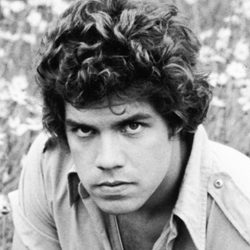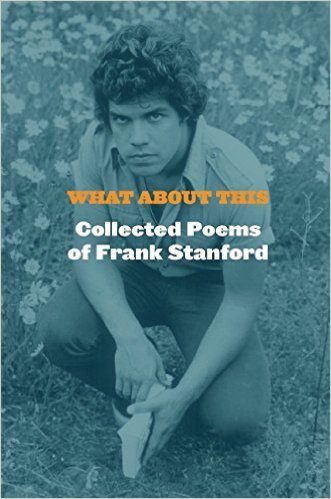
“With few exceptions,” Joseph Brodsky wrote in “On Grief and Reason,” his homage to Robert Frost, “American poetry is essentially Virgilian, which is to say contemplative. That is, if you take four Roman poets of the Augustan period, Propertius, Ovid, Virgil, and Horace, as the standard representatives of the four known humors (Propertius choleric intensity, Ovid’s sanguine couplings, Virgil’s phlegmatic musings, Horace’s melancholic equipoise), then American poetry—indeed, poetry in English in general—strikes you as being by and large of Virgilian or Horatian denomination.”
What Brodsky doesn’t allow is that a single American poet might’ve possessed aspects of all four models—Emily Dickinson likely comes closest.
I’ve been reading this summer What About This: Collected Poems of Frank Stanford, published by Copper Canyon Press, and while I’ve been an admirer of Stanford’s poems for nearly thirty years, I’m struck this time by how much he seems to embody this Brodsky principal. More than that: his poems possess four major concerns that are also the cornerstones of American poetry over the past several generations. In Stanford’s poems, as with many corners of American poetry, there’s the continual search for new narratives (Horace), a trust in private, regional geographies of both inner and outer feeling (Propertius), a belief in the erotic imagination (Ovid), and finally a striving for new combinations of meaning and forms (Virgil). I’ll say more about those four characteristics in a moment.
I can think of just three contemporary American poets of the 20th century who have been kept in print and extolled in essays and poems and carried forth—carried aloft—by friends and editors as often, as lovingly, and as fiercely as Frank Stanford has been. I’m thinking of Sylvia Plath, first and foremost. I’m thinking of Weldon Kees, who was championed for decades by Donald Justice. I’m thinking of Larry Levis, whose legion of supporters is long and includes especially Philip Levine and David St. John. Of course there are others. My point is that Frank Stanford, who committed suicide by shooting himself three times in the chest a month before his 30th birthday in 1978 in Fayetteville, Arkansas, has had an underground, cult influence on American poets for a generation and has been kept alive practically one stanza at a time. The only way I can put it is, no American poet I have ever met regardless of disposition or poetics has disliked Frank Stanford’s poems. So there’s that. My meaning is, younger poets are attracted to Stanford’s youthful, meteoric exuberance. He is, like Hart Crane who also died young by suicide, a young poet’s young poet.
Born in Richton, Mississippi in 1948, Stanford was adopted by a single mother into a upper middle-class Memphis family. The family moved to Mountain Home, Arkansas, in the early 1960s, and Stanford attended but did not graduate from the University of Arkansas. In 1976 he founded Lost Roads Publishers, later taken over by C. D. Wright, with whom he lived the last few years of his life. His partying life is legendary. Years of hard living got mixed together with a ferocious writing pace that would carve a new identity in American poetry. If identity can be said to be the subject of all American poetry, then Stanford, like his generational peer Bob Dylan with whom he shares both gumption and a post-Beat strut, fashioned a fresh American myth out of the geographies of his imagination. Had he lived, this year he would’ve turned 67.
What About This, edited by Copper Canyon publisher Michael Wiegers, gives Stanford the gigantic volume his devotees have long wished for and readers of American poetry have desperately needed. It includes all of his published books interspersed with stretches of excerpts from his 500-page epic jumble on love and social justice, “The Battlefield Where the Moon Says I Love You,” as well as a trove of drafts, fragments, and unpublished work. His poems are savant eruptions in the spirit, but not the style, of Hart Crane, as I say. And: They sharply blend John Berryman’s lyric virility and obsession with death with Frank O’Hara’s need to be loved. They are a counterweight to John Ashbery’s urban convexities but also a post-Fugitive successor to Robert Penn Warren and especially James Dickey’s urgent reclamations for an earthier, less Confederate sound in the Anglo poetry of the Jim Crow American south. Stanford’s poems don’t just flirt with the subject of death, they adopt death as his art’s primary figure and force. Death becomes the bootlegger muse for his torrid imagination—reading all this work of Stanford, I guess, it’s clear, above all, that he adored William Blake.
They are a counterweight to John Ashbery’s urban convexities but also a post-Fugitive successor to Robert Penn Warren and especially James Dickey’s urgent reclamations for an earthier, less Confederate sound in the Anglo poetry of the Jim Crow American south. Stanford’s poems don’t just flirt with the subject of death, they adopt death as his art’s primary figure and force. Death becomes the bootlegger muse for his torrid imagination—reading all this work of Stanford, I guess, it’s clear, above all, that he adored William Blake.
In short, Stanford is an American original in an art form that has had few. Like Walt Whitman and Emily Dickinson, he can’t be imitated without your sounding exactly like him. Like W.S. Merwin, he speaks from the flesh in a world of mystery—but unlike Merwin, Stanford never pokes his head into the shadow of unconsciousness. Like Wallace Stevens, Stanford imagines into being a new language of possibility and despair. But where Stevens’s world is almost entirely depopulated, Stanford’s world consists of witnesses who speak in a lingo of “slop buckets” and “singing knives” and “loads of buckshot” and who, with a “posse of vigilantes” and friends, have run “out of money and time.” If you ever wondered what Bill Clinton’s Id looks like if it were fashioned into the form of a poem composed in a dialect of dirt-under-the-finger-nails expressionism and a zany lyricism touched with cozy Hope and raucous Hot Springs, read Frank Stanford.
I first wrote about Stanford in the early 1990s for the now-defunct Plum Review, reviewing Leon Stokesbury’s slender selection of Stanford’s poems, The Light the Dead See: Selected Poems of Frank Stanford, published by the University of Arkansas Press. I was—well, blown away is the only way to put—blown away by his exuberance and the way he wrote in a language that was entirely familiar to me given that I grew up one state over in east Texas. This little bit of verse—“I…watched the clouds // Mosey over / Like blind men / Picking apples”—was the kind of thing that had always been ringing in my ears in the post-Brown vs. Board of Education south. Or something like these lines, too, about the “saloon and short order cafe on the side of the state highway” called Snatch:
Snatch’s wasn’t one of those rolling kind of places
just a few drinks and pin balls and eats
a lot of truck drivers and family men went there
I was thinking they might of had some action
a fight to run folks off maybe the state boys closed him down
Snatch was outside by his car down on one knee
with the door open listening to the radio shaking his head
he had on a day glow furlined cap
and was smoking the last part of his cigar
what’s up Snatch says I
he let me call him Snatch instead
of Mr. Snatch because I’s good on Big Leaguer Pin Ball
All four of the major characteristics of Stanford’s writing are in view in this passage. More than that. These four concerns are also, as I mentioned at the beginning of this column, the cornerstones of American poetry over the past several generations. To reiterate, there’s the continual search for new narratives, a trust in private, regional geographies of both inner and outer feeling, a belief in the erotic imagination, and finally a striving for new combinations of meaning and forms.
In Stanford’s search for new narratives you get neo-Modernist plot lines that remind you a little of Robert Penn Warren and a lot of James Dickey. That passage quoted above footnotes rather than renders its narrative situation. Stanford’s narrations— “he let me call him Snatch instead / of Mr. Snatch”—make you wonder if any of his local places, his local colors, his local crossroads, exist in time or only in the realm of poetry because they’ve become electrically transfigured. I think of a poem like James Dickey’s “The Heaven of Animals” as a precursor for the ways Stanford bends narratives of place to surrender to art:
with a feather I ordered them
to salute the adventures
of their skin
the blue like a constellation
of women prepared to undress
the yellow one who yodeled
the twig’s tornado
the orange one to be done with another poet
the final one hanging
like the noose of midnight
the rainbow of pure reason
the fork in the flooded road
the hypotenuse of the spittoon
These lines exemplify a narrative of psychic reorientation. They argue that the landscape one lives in begins always with your own body.
Second, Stanford’s trust in a private imagination might remind you of his affection for Faulknerian realities. The older Snatch allows the poet into his company because the poet is a master of the bell-ringing ricochet. That same alert respect for action and character comes across again and again in Stanford’s poems, especially when you meet his infamous cadre of buddies: O.Z., Tangle Eye, Chinaman, Ray Baby, Six Toes, to name only a few. These dudes are blood brothers in the spirit of Kerouac:
Before he stole Mr. Charlie’s sedan
Chinaman rocked along the cuts dead easy,
chopping cotton, singing like a kaydid.
It was a long time ago on a low turn row,
when he took his bimbo for a ride
in the bossman’s car. They saw someone
getting buried in the Bogue Phalia River.
When Chinaman got picked up for stealing,
he told his gal to keep her mouth shut:
“Don’t say nothing, till I get out of prison.”
Third, Stanford’s half-sexual eroticism—“just a few pinballs and drinks and eats”—in which things like “fish hooks” and “homemade wine from a jar” become correlatives for the flesh, where the lonely and the loved are often as not “half naked” going “about their chores,” and where time and the human body untie in the “same pool”:
The night, the child, the moon, the drunken sailer
the woman who wears through her ring like
a pair of Levis that last and last,
the blind Negro who taught me how to strut
when I was six, the look you gave me
the other day, whoever you are, the brave
and the lonely, the animals that see us,
a long time before we shoot them, the bank robber,
the drifter, all of us drink
from the same pool. So, when we meet,
let’s float down together, sane,
stoned, drunk, whatever, like those indigo
dragonflies of spring that will be here
soon.
Finally there’s Stanford’s blazing, un-dreamy surrealism—“what’s up Snatch says I”—in which innocence is continuous:
Children trying on gloves. Children in the garden of their retinas.
Children forgetting
The mystery of the ambushed clock, the mirror
Weighing down the thigh like a heavy knife.
Children like bullets in pain. Children
Like a cemetery of dreams, ships running guns.
Held to the veranda by a ghost and blackbird pie,
Held to the dark by invisible binoculars. Children
In the garden of the moon, provocateurs of meat.
“I don’t believe in tame poetry,” Stanford once said, “Poetry busts guts.” And so you get an American poetry that is wide-open to the flood of the imagination. And so finally there’s this. His poems will convince you a final characteristic of American poetry—that American poetry is always young, always renewing itself, and always ready for renewal.




